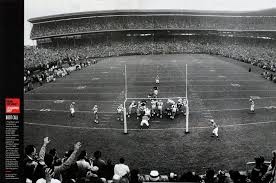
Goalposts are not as stable as you may have been led to believe.
In the middle of the lines forming the ends of the field, the goal-posts are erected, and should be 18 feet 6 inches apart, with a crossbar 10 feet from the ground. The posts should project several feet above the cross-bar.
– 1892 Football rulebook
The NFL started in 1920 and used the above rule for the goalposts. Then, in 1927, the NCAA moved the goalposts off the goal-line and had them installed on the line at the back of the end zone. Naturally field goals became harder. The NFL followed the NCAA rules.
You might wonder why the pro football was following college rules? That’s because for most of the twentieth century college football was king. In fact, the reason pro football is on Sunday is because in the early days of the league, they didn’t think they could, or wanted to compete with college football which ruled Saturdays.
In 1933 the pro football league got around to writing their own rule book. They moved the goalposts back to the end zone line. It certainly helped scoring increase and cut down on ties.
In 1966 the NFL moved the goalposts again. The moved the posts off the goal line and stated they should be 20 feet tall. The following year, 1967 they moved them again. This is when they introduced the “slingshot” style of posts. That cut the number of posts players cut potentially run into in half.
The next change in goalposts was in 1974, this time they pushed them back to the endline again. This made field goals harder, (Ten yards harder, actually) because touchdowns are more exciting than field goals.
In 2014 the NFL extended the height of goalposts from 30 feet (10 feet below the bar and 20 feet above) to 35 feet. Below is still 10 feet.
In 2015 the league shrunk the distance between the goalposts stanchions from 18.5 feet apart which it had been for about 100 years to 14 feet wide. The experiment didn’t last long and they are now back at the “traditional” width of 18 feet 6 inches.
One of the things they teach you in Project Manager school (PMP) is a problem called “Scope Creep.” Scope creep happens when you start with a well defined project and stuff keeps getting added. It typically results in blowing your schedule, your budget or both.
Movies are famous for it. I’m not involved in the movie business, but some of my friends are. Movie budgets measured in the hundreds of millions of dollars can spin out of control. It puts them in a position where a movie could be a huge hit, but not be able to recoup it’s original cost.
We have a few employees in India that are assigned to my client. The rest of our employees assigned to my client are all in the United States, in big, strong, call centers. My client’s data is completely segregated from any other of my company’s client data. That’s easy when we build an entire call center around our one client.
But, in India I only had a couple of people. Originally, we just configured their computers to be secure.
Hey, could you guys move your agents so they are sitting with their backs to wall so no one else can see their screens?
Sure, that’s not hard, right? Just move them around.
Could you guys put your agents into like an office that is just for them?
Yeah, that’s not terrible difficult.
It needs to have a card reader on the door.
Okay,
And, of course we need cameras inside the room and covering the door.
Of course.
And we noticed that the data stream for these agents flows through the same data closet as the other people in the office. We need you to segregate that traffic.
Okay. . .
And it needs to be in a locked cage, that has a key and a log of anyone that access it.
Scope creep. I wasn’t the project manager for the entire project, but I took it over part way through.
I was thinking a lot about those moving goalposts. We did what the client asked, of course. They are the ones paying the bills, after all.
But, knowing that the NFL has been moving goalposts for the past 100 years makes me feel a little better about putting up with it for the past 14 months.
Stay safe
Rodney M Bliss is an author, columnist and IT Consultant. His blog updates every weekday. He lives in Pleasant Grove, UT with his lovely wife, thirteen children and grandchildren.
Follow him on
Twitter (@rodneymbliss)
Facebook (www.facebook.com/rbliss)
LinkedIn (www.LinkedIn.com/in/rbliss)
or email him at rbliss at msn dot com(c) 2021 Rodney M Bliss, all rights reserved